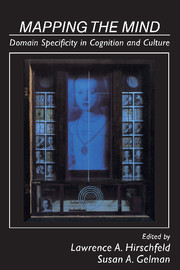Book contents
- Frontmatter
- Contents
- List of contributors
- Preface
- Part I Overview
- Part II The origins of domain knowledge: Biology and evolution
- Part III The origins of domain knowledge: Conceptual approaches
- Part IV Are domains theories?
- Part V Domains across cultures and languages
- 14 First principles can support both universal and culture-specific learning about number and music
- 15 Cognitive constraints on cultural representations: Natural ontologies and religious ideas
- 16 Universal and culture-specific properties of children's mental models of the earth
- 17 Cognitive domains and the structure of the lexicon: The case of the emotions
- Part VI Implications for education
- Author index
- Subject index
15 - Cognitive constraints on cultural representations: Natural ontologies and religious ideas
Published online by Cambridge University Press: 04 August 2010
- Frontmatter
- Contents
- List of contributors
- Preface
- Part I Overview
- Part II The origins of domain knowledge: Biology and evolution
- Part III The origins of domain knowledge: Conceptual approaches
- Part IV Are domains theories?
- Part V Domains across cultures and languages
- 14 First principles can support both universal and culture-specific learning about number and music
- 15 Cognitive constraints on cultural representations: Natural ontologies and religious ideas
- 16 Universal and culture-specific properties of children's mental models of the earth
- 17 Cognitive domains and the structure of the lexicon: The case of the emotions
- Part VI Implications for education
- Author index
- Subject index
Summary
The point of a cognitive approach to cultural representations is to put forward a series of causal hypotheses in order to account for certain features of cultural phenomena. Central to such an inquiry is the notion of cognitive constraints; given the general properties of human minds, certain types of representations are more likely than others to be acquired and transmitted, thereby constituting those stable sets of representations that anthropologists call “cultures.” To many anthropologists, cultural phenomena seem to lie outside the scope of cognitive constraints, due to three types of reasons: their ontological status, their variability, and their transmission. Cultural anthropology generally focuses on abstract systems of “symbols,” “codes,” or “meanings,” the properties of which are supposed to be independent of the way they are represented in human minds. Second, cultural representations are considered as intrinsically variable; as a consequence, it seems difficult to appeal to universal properties of human minds in their description or explanation. Finally, the content and organization of cultural representations, in competent members of a culture, seem to be entirely constrained by what subjects were taught through social interaction. Against these assumptions, I will take as a starting point the following principles:
Cultural systems can and must be studied as sets of mental representations acquired and stored by human minds, because acquisition and memorization processes impose strong constraints on the contents and organization of cultural representations.
Their undeniable variability should not lead us to ignore important recurrent features, which deserve an explanation.
[…]
- Type
- Chapter
- Information
- Mapping the MindDomain Specificity in Cognition and Culture, pp. 391 - 411Publisher: Cambridge University PressPrint publication year: 1994
- 53
- Cited by



